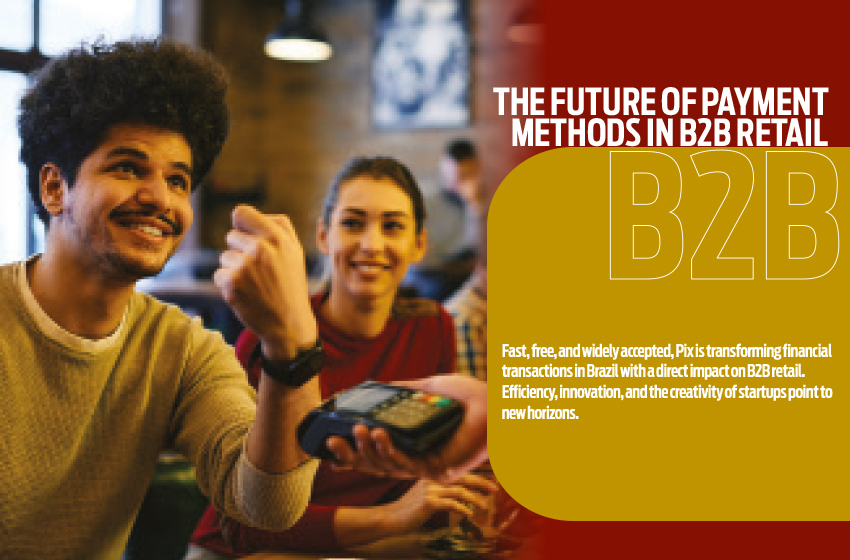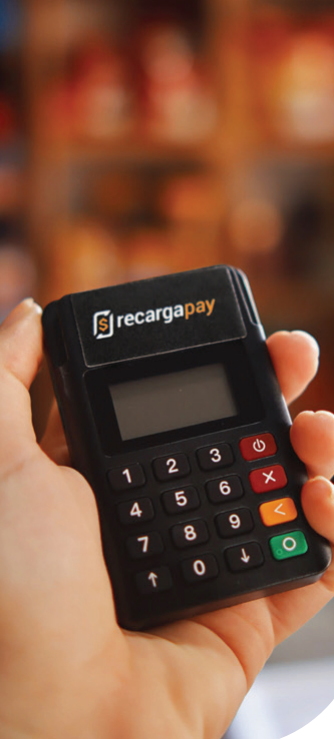
The future of payment methods in B2B retail
Fast, free, and widely accepted, Pix is transforming financial transactions in Brazil with a direct impact on B2B retail. Efficiency, innovation, and the creativity of startups point to new horizons.
By Igor Lopes

The payment methods market in Brazil is undergoing an unprecedented revolution. Driven by the massive adoption of Pix and the emergence of startups offering innovative solutions, the sector has consolidated itself as a strategic pillar for the development of B2B retail, which involves industries, distributors, and retailers in large-scale operations.
Since its launch in 2020, Pix has transformed financial transactions in the country. More than just a fast and free method for transfers, it has evolved to meet more complex demands, such as those of the corporate sector. Central Bank data shows that 33% of commercial transactions already use Pix, and the expectation is for accelerated growth with the launch of features such as Pix Garantido, which offers security for installment payments, Pix Automático, for recurring transactions, and Pix Internacional, designed to facilitate global negotiations.
These innovations have a direct impact on B2B retail, a segment where extended terms, financial predictability, and high-volume transactions are fundamental characteristics. According to experts, the possibility of making immediate payments with greater flexibility places Pix at the center of the sector’s financial digitalization.
The role of startups

In addition to the advancement of Pix, Brazilian startups are playing a transformative role in modernizing payment methods. Among them is RecargaPay, which combines innovation with practical benefits for retailers and businesses. One of its most relevant solutions for the market is installment-based Pix, which allows customers to split payments into up to 12 installments on a credit card, while the retailer receives the full amount immediately.
“We started offering installment-based Pix in January 2021, three months after the launch of conventional Pix, when we understood this opportunity. And now, with the new modalities offered by the Central Bank, Pix will try to replicate the logic of the credit card, but in a better way because it simplifies the payment chain a bit. It removes some intermediaries that suck fees in the middle of the process,” says Wenceslao Frers, senior VP of B2B. “In this way, by replacing the credit card, which costs 3-4% for the store, this will cost 1% with Pix, and the entire system improves,” he adds.
The platform works not only for large retailers but also for small and medium-sized businesses. By offering features such as cashback, bill payment, and service top-ups, small retailers can increase their margin. Rodrigo Silva, owner of a small establishment in Barueri, Greater São Paulo, uses these resources to generate more revenue and attract more customers to his store. “People come here, pay a bill, end up buying a candy, a snack, a cell phone case. And by paying the bill through RecargaPay, I earn cashback per transaction. I also earn cashback when I top up customers’ cell phones,” he says.

Another example of innovation is Conta Comigo Digital, which makes life easier for companies that issue invoices and for banks that receive these payments. The solution connects the invoices of companies that are scattered in the banking system to the end consumer, within their own bank. “We see a portion of the retail sector that wants to get out of the barcode with the intention of passing that charge to the QR Code and Pix. In this sense, Conta Comigo can integrate this sale and this QR Code with the banking institution, and this charge will appear for the customer within the bank, along with other consumer bills,” explains Vinicius Santos, founder and CEO at Conta Comigo.
“We also expanded security because only the establishment associated with Conta Comigo can issue this payment request. An invoice from a store, for example, can be sent to the bank even with a solution or a visual differential to prevent fraudsters from imitating this charge,” he adds.

A third Brazilian startup that has been gaining prominence in the sector is Asaas, which facilitates the management of collections, payments, and financial control. Through automated processes, it offers some services that simplify the day-to-day operations of companies. “Imagine that I have an e-commerce that needs scale or quick solutions on certain dates. With Asaas, I can integrate partners in a simple way,” explains Eduardo Kruger, vice president of products at Asaas.
A practical example is a client who has different payment arrangements with several partners. “Imagine a client who works with commissions and needs a platform that makes these payments quickly, securely, and transparently. That’s where we come in and help with transactions and integrations.”
The combination of innovation, efficiency, and integration will be the path for companies that want not only to follow, but to lead the next stage of this financial revolution.
Another notable example is Dotz, a startup that combines loyalty programs with innovation in payment methods. By integrating a solution that allows consumers to accumulate and use points directly in retail purchases, Dotz not only encourages their loyalty but also simplifies financial transactions. One of the great advantages of participating in a loyalty program is the possibility of upselling: by having contact with the customer offering discounts, the retailer can promote more impulse sales or ensure the brand’s permanence in the customer’s memory. “We understand that this is one of the best ways to provide greater purchasing power for the population, while encouraging retailers to promote their products and generate revenue from the base,” comments Rafael Rapp, retail director at Dotz.

Irreversible trend

These startups are part of a larger trend of platforms that integrate payments with financial management, meeting a growing need for simplification and efficiency in B2B retail. Other Brazilian companies such as Mercado Pago, PagSeguro, and Zoop have also expanded their offerings with specific solutions for the segment, through integrated machines, omnichannel payments, or tools that connect sellers and buyers more efficiently.
Startups are part of a larger trend of platforms that integrate payments with financial management, meeting a growing need for simplification and efficiency in B2B retail.

The modernization of payment methods improves the operational experience and also brings significant economic gains. Studies show that the adoption of digital payments can reduce operational costs by up to 25%, in addition to increasing cash flow predictability. For retail, this translates into greater competitiveness, especially when dealing with suppliers and customers in increasingly demanding markets.
The impact also extends to international trade. Pix Internacional, currently under development, promises to eliminate intermediaries and reduce fees in global operations, which will be a strategic differentiator for companies that import or export products. In an increasingly globalized world, this functionality can redefine the dynamics of Brazilian foreign trade.
Challenges of transformation
However, this transformation is not without its challenges. The implementation of new technologies requires investment in infrastructure, training of teams, and increased attention to digital security. Cyberattacks and fraud still pose significant risks, requiring companies to adopt robust data protection solutions.
Despite this, the sector is advancing rapidly. With examples such as RecargaPay, Conta Comigo Digital, Dotz, and Asaas, and with the constant improvements in Pix and other digital tools, Brazilian B2B retail is positioning itself at the forefront of the payment methods transformation. The combination of innovation, efficiency, and integration will be the path for companies that want not only to follow, but to lead the next stage of this financial revolution.
The future of payment methods is not just digital. It is integrated, agile, and strategic. And, for retailers and industries, embracing these changes means paving the way for sustainable and competitive growth in an ever-evolving market.

Source: Eletrolar News Ed. 164





